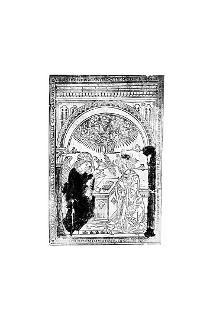OGGETTO
SOGGETTO
PROVENIENZA
DATAZIONE
AUTORE
STATO DELLA STAMPA
STATO DI CONSERVAZIONE
MODALITÀ DI CONSERVAZIONE
RESTAURI
ISCRIZIONI
STEMMI, MARCHI
NOTIZIE STORICO-CRITICHE
Chiaroscuro woodcut from 2 blocks, gray-brown/black Inscriptions: “TICIANVS” and “Vgo” in the line block State: only Saint Jerome, inscribed with the names of both Titian and Ugo, os the earliest chiaroscuro woodcut of Italian invention and execution. Although the print is undated, we can nevertheless place its making between that of Ugo’s four-block woodcut Sacrice of Abraham after Titian, published by Bernardino Benalio in or slightly before 1515 (the print is not dated but must have been completed by the time it was mentioned in Benalio’s privilege to the Venetian Senate. Although the attribution of the entire design is debated, there is some agreement that Titian’s hand was behind part of the composition. See most recently Landau 2016 and Joannides 2001, 282), and the printmaker’s petition for a privilege in 1516, in which he claimed the invention of the chiaroscuro technique. The petition does not record any specific prints having been made; however, prior to submitting it Ugo must have successfully completed at least one example and felt that such a protection of his financial investment was warranted. This print, one can presume, was Saint Jerome, Ugo’s only chiaroscuro woodcut after a Venetian design. Here, Ugo adopted the most basic approach: the line block dominates, with tone block highlights applied sparingly but effectively. Modern discussions of the Saint Jerome print call attention to Titian’s pen and ink Saint Sebastian, noting the similarity of gure type and drawing style (Saint Jerome, study for the Averoldi alterpiece in Brescia, c. 1519/20, pen and brown ink, with brown wash ahd white heightening, on gray-blue paper, 18.2x11.5 cm, Städel Museum, Frankfurt am Main, Graphische Sammlung, inv. 558, recto). Although produced a few years later, Titian’s study of Saint Sebastian exemplifies the challenge Ugo faced in fixing such rapid, energetic pen strokes in woodcut, regardless of whether the design was laid down onto the block by Titian, or transferred from a drawing (Titian’s role in the production of conventional woodcuts after his designs remains unclear). In Saint Jerome, Ugo captures the vitality of Titian’s sketched lines that assert movement through the torsion of the penitent saint’s tensed figure. A comparison of six impressions of this rare print reveals slight variations in the white highlight patterns. The present impression closely resembles one in the Albertina, which also uses a gray-brown tone block and shares the same white highlights (Albertina DG2002/324). Notably, both sheets are printed with moderate pressure using well-formulated inks, resulting in crisp and clearly individuated lines. In the four other impressions, all printed with a warm, red-brown tone block, Ugo deployed more fluid inks and printed the blocks under greater pressure. These diluted inks spread beyond the edges of the cut forms (see complete list below). As a result, there is a loss of detail in the passages of tight line work and some of the highlights are filled in (Landau and Urbini noted the diluted appearance of the ink in the Paris and Parma sheets, describing them as experimental proofs; Landau 1984 and Urbini in Ugo da Carpi 2009). For this reason, it remains an open question whether the differences in highlights between the gray-brown and red-brown impressions—including the slightly diminished highlights on the saint’s head and proper left shoulder in the latter examples—are the result of a replaced or altered tone block (as conjectured by Rosand and Muraro in Tiziano e la silografia 1976, p. 93, n. 6), or the product of inconsistent ink and printing quality. The Paris impression of Saint Jerome is printed in red- brown ink on paper that bears a Crossbow in a Circle Surmounted by a Star watermark, a type commonly found in Ugo’s early Roman prints. From this, one might infer that Ugo brought the blocks for this chiaroscuro woodcut from Venice to Rome, and subsequently printed the red-brown impressions once he set up his printing works there. Naoko Takahatake, The Chiaroscuro Woodcut in Renaissance Italy, exhibition catalogue, Los Angeles County Museum of Art, June-September 2018, National Gallery of Art, Washington D.C, October 2018-January 2019, DelMonico Books/Prestel, Munich-London-New York, 2018, pp. 64-65. Other impressions: -Vienna, Albertina DG2002/324 (similar palette to BM sheet): https://www.graphikportal.org/document/gpo00080121 -Berlin, Kupferstichkabinett 230-1920: red-brown/black https://www.graphikportal.org/document/gpo00173702 -Parma, Biblioteca Palatina inv. 13199 bis: red-brown/black -Devonshire, Chatsworth: Vol. IV, fol. 38, n. 56: red-brown/black -Paris, Louvre Rothschild 4390: red-brown/black http://arts-graphiques.louvre.fr/detail/oeuvres/9/519487-Saint-Jerome-max: red-brown/black -Brema, Kunsthalle inv. 34139.
DOCUMENTAZIONE FOTOGRAFICA
REPERTORI
BIBLIOGRAFIA
https://www.thelacmastore.org/products/the-chiaroscuro-woodcut-in-renaissance-italy?_pos=1&_sid=ce2a0cc2a&_ss=r



